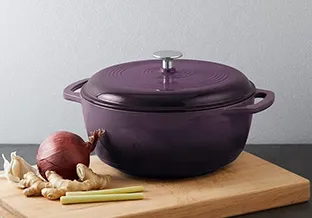
Perfecting the Art of Seasoning Your Cast Iron Skillet for Optimal Cooking Performance
Seasoning Your Cast Iron Skillet A Complete Guide
Cast iron skillets are cherished kitchen tools, revered for their durability, versatility, and ability to retain heat. They can last a lifetime, but to reap their benefits fully, proper seasoning is essential. Seasoning creates a natural non-stick surface, prevents rust, and enhances the skillet's cooking performance. Here’s a comprehensive guide on how to season your cast iron skillet effectively.
What is Seasoning?
Seasoning refers to the process of treating the surface of the cast iron with a layer of fat or oil and heating it to create a thin, protective coating. This layer not only helps food release easily but also develops over time, giving your skillet unique flavor profiles while protecting it from corrosion.
How to Season Your Skillet
1. Gather Your Supplies You will need a cast iron skillet, a clean cloth or paper towels, and an oil with a high smoke point. Good choices include vegetable oil, flaxseed oil, or canola oil. Avoid using butter or olive oil, as they have lower smoke points.
2. Clean the Skillet Start with a clean skillet. If it’s seasoned but not in good condition, scrub it with hot water and a stiff brush to remove any stuck-on food or rust. For heavier rust, you might need to use steel wool. Rinse and dry the skillet thoroughly – water and cast iron are not friends!
3. Apply the Oil Once the skillet is dry, pour a small amount of oil onto the cooking surface. Using a cloth or paper towel, spread the oil evenly across the entire surface, including the sides and the bottom. Make sure to apply just a thin layer; too much oil can lead to a sticky finish.
seasoning your cast iron skillet

4. Heat the Skillet Preheat your oven to 450°F (230°C). Place the skillet upside down on an oven rack to catch any drips. You can put a sheet of aluminum foil on the lower rack to catch excess oil that might drip off. Bake the skillet for one hour. This high temperature allows the oil to polymerize, creating a hard, non-stick surface.
5. Cool Down After one hour, turn off the oven and let the skillet cool inside. This gradual cooling helps to prevent cracking. Once it’s cool, it’s ready for use.
Maintaining Your Seasoned Skillet
To keep your skillet well-seasoned, avoid washing it with soap. Instead, use hot water and a stiff brush to clean it immediately after use. For tougher residue, a little coarse salt can work as an abrasive scrub. After cleaning, dry the skillet thoroughly and apply a light coat of oil before storing it to maintain the seasoning.
Regular Re-Seasoning
Over time, you may notice your skillet doesn’t perform as well as it did when new. This could be due to scratches or wear on the seasoning layer. It’s a good idea to periodically re-season your skillet to keep it in top shape. You can do this by following the same steps outlined above whenever you notice a decline in performance.
Conclusion
With proper seasoning and maintenance, your cast iron skillet can become a cherished cookware piece that improves with age. This seasoning process not only enhances the cooking experience but also instills a sense of tradition and care in your kitchen. So, grab your skillet and start seasoning – happy cooking!
-
Season Cast Iron Perfectly with GPT-4 Turbo TipsNewsAug.01,2025
-
High Quality Cast Iron Cookware - Baixiang County Zhongda MachineryNewsAug.01,2025
-
Premium Cast Iron Pan: Durable & Perfect HeatNewsAug.01,2025
-
High Quality Kitchen Durable Black Round Cast Iron Cookware Pancake Crepe Pan-Baixiang County Zhongda Machinery Manufacturing Co., Ltd.NewsAug.01,2025
-
Cast Iron Cookware - Baixiang County Zhongda Machinery | Nonstick, Heat ResistanceNewsAug.01,2025
-
High Quality Kitchen Durable Black Round Cast Iron Cookware - Baixiang County Zhongda Machinery | Non-Stick, Heat Retention, DurableNewsJul.31,2025


